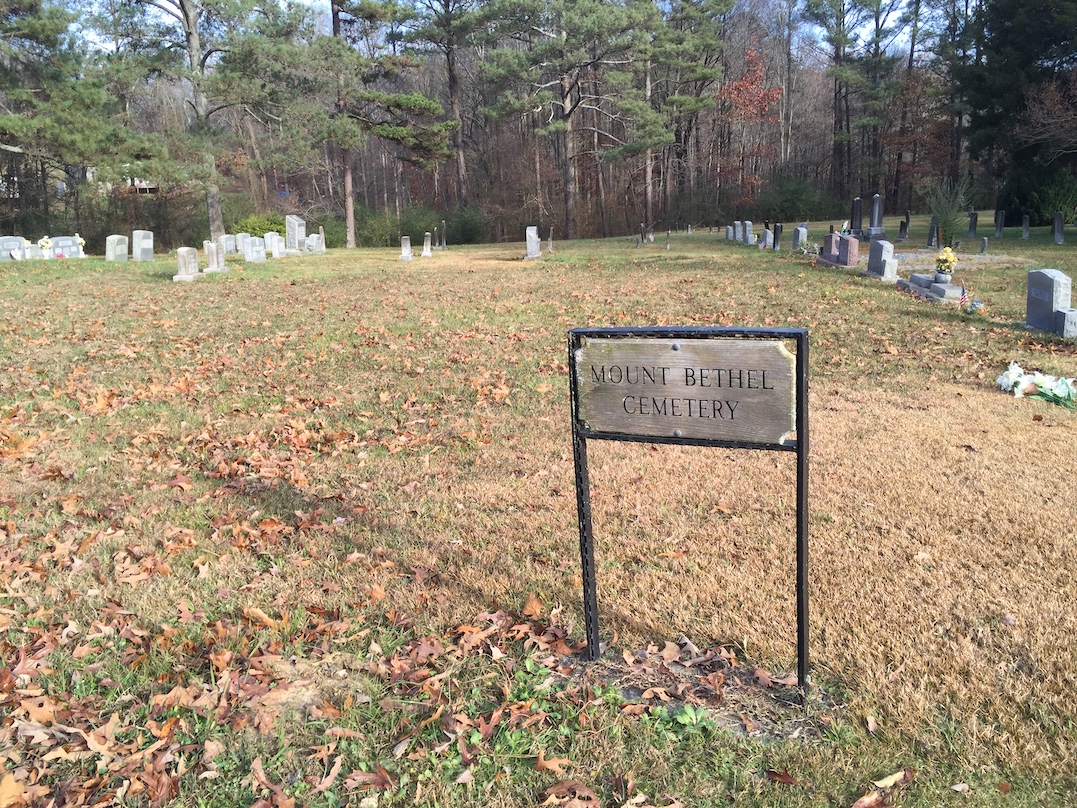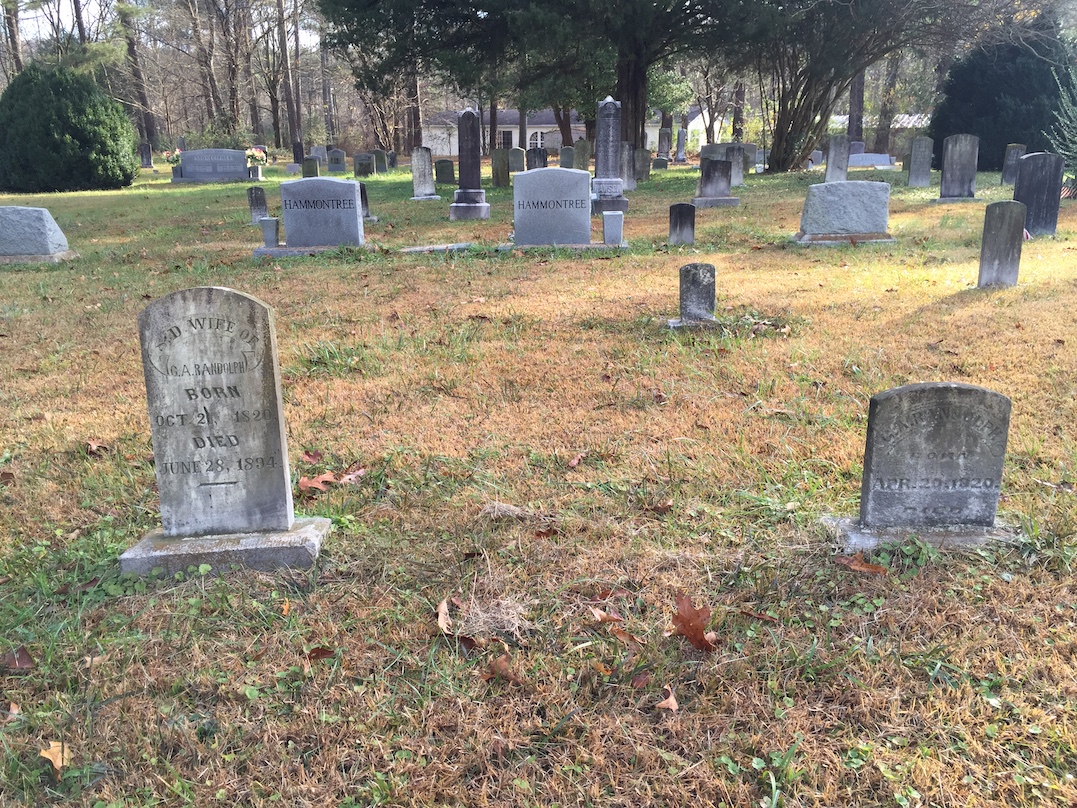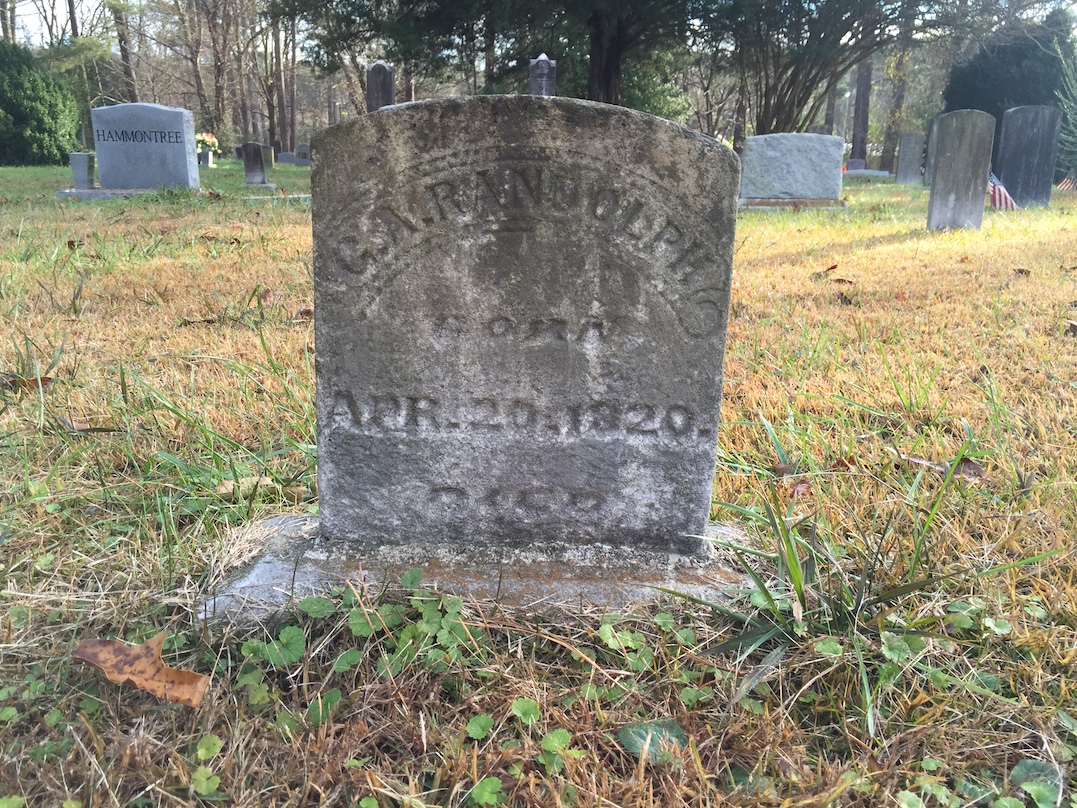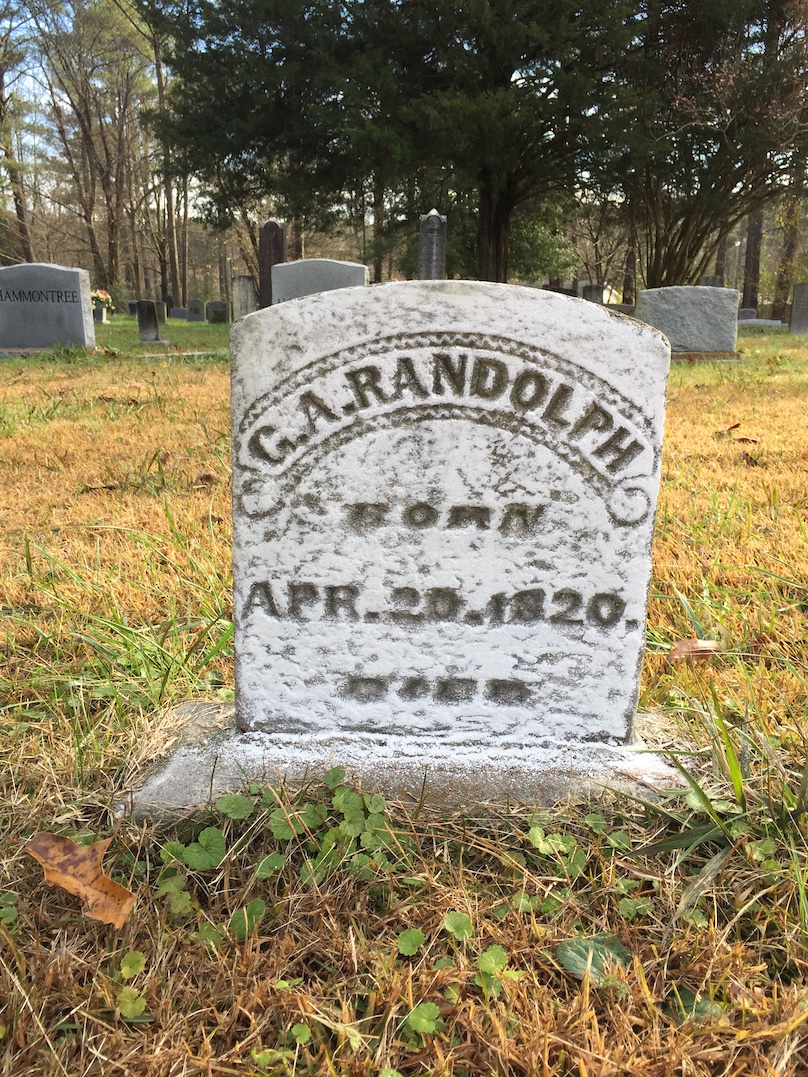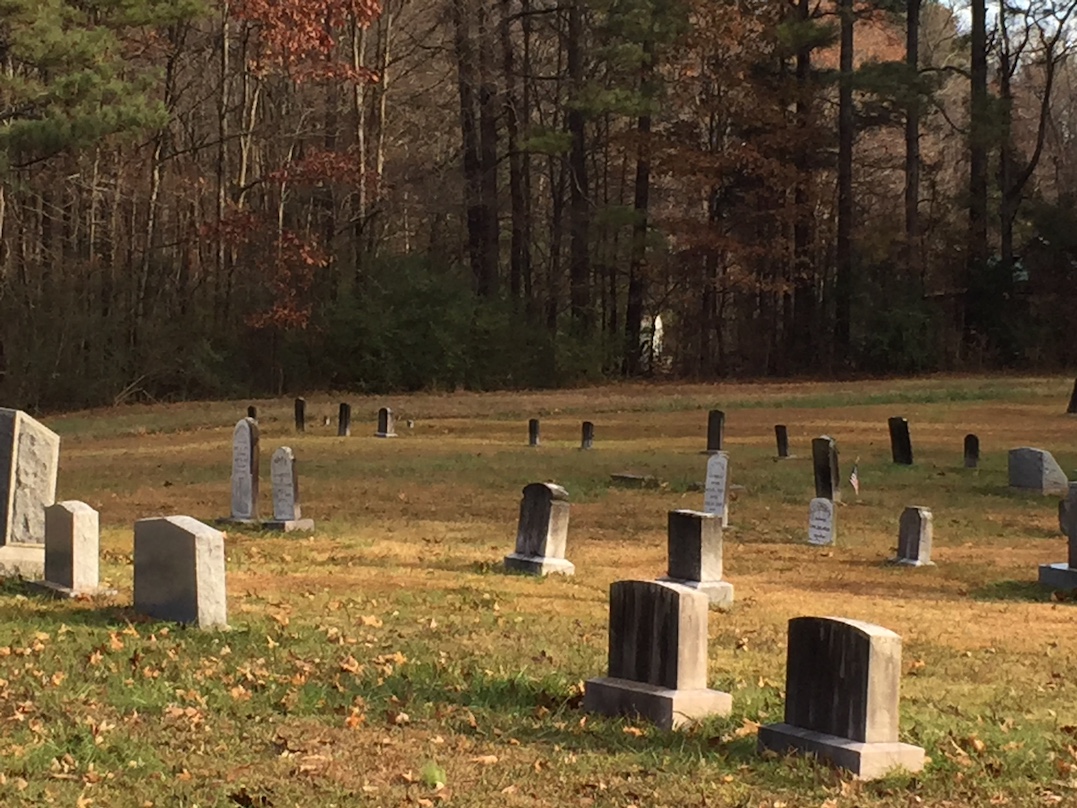Gilbert A. Randolph
1820-1885
[need picture]
![]()
The Life of G. A. Randolph
Gilbert A. Randolph was born in Tennessee April 20, 1820. He was the son of William Byrd Randolph, Jr. (1764-1824). Gilbert's grandfather, William Byrd Randolph, Sr., was a Baptist minister, who around 1810 determined to preach the Bible alone, distancing himself from all creeds of man. Records of his departure appear in the Autobiography of Abner Hill. Randolph is listed as being a part of that group of Baptist ministers with others like Thomas McBride, John and his brother, Philip Mulkey, Thomas and his brother Cordo Stone, and several others. It is assumed that, like his grandfather, his father, William, Jr. was a preacher, though little is known of his ministry. More is known of Gilbert's two uncles, Robert B. Randolph (1789-1865) and Elihu H. Randolph (1803-1850) who preached the gospel.
Gilbert and his brother Gilmore Randolph (1822-1904) were among those of the third generation promoting New Testament Christianity during their days. Gilbert was known for his ability to admonish response. J. D. Floyd wrote on the restoration preacher, Rees Jones. Floyd wrote, "Rees Jones was strictly original in his methods. He studied out the great themes of the gospel for himself, and many a preacher o! greater note got his material from him. He was wholly lacking in the gift of exhortation, and hence he influenced people by reason alone. On one occasion, when with me, he spoke of Gilbert Randolph, one of his early companlons in labor. He said that Randolph had one gift be never saw in any other man. He could get up after another had preached and at once go into a warm, pathetic exhortation. I said I did not think much of exhortation as it took strong argument to reach me. "Ah," he said, and the tears coursed down his cheek, "of all gifts I ever coveted, it was the gift of exhortation. To see men I know are taught and not have the power to move them to act, it grieves me to the heart." (GA, 02.09.1911, p.164)
G. A. Randolph worked many years among the churches in Tennessee and Georgia to promote the cause of Christ.
He was married initially to Sarah Doranda Myers Randolph (1820-1894) September 16, 1838. He passed from this life March 24, 1885 in Cleveland, Bradley County, Tennessee. Burial followed in the Mount Bethel Cemetery.
-Scott Harp 07.13.2021
![]()
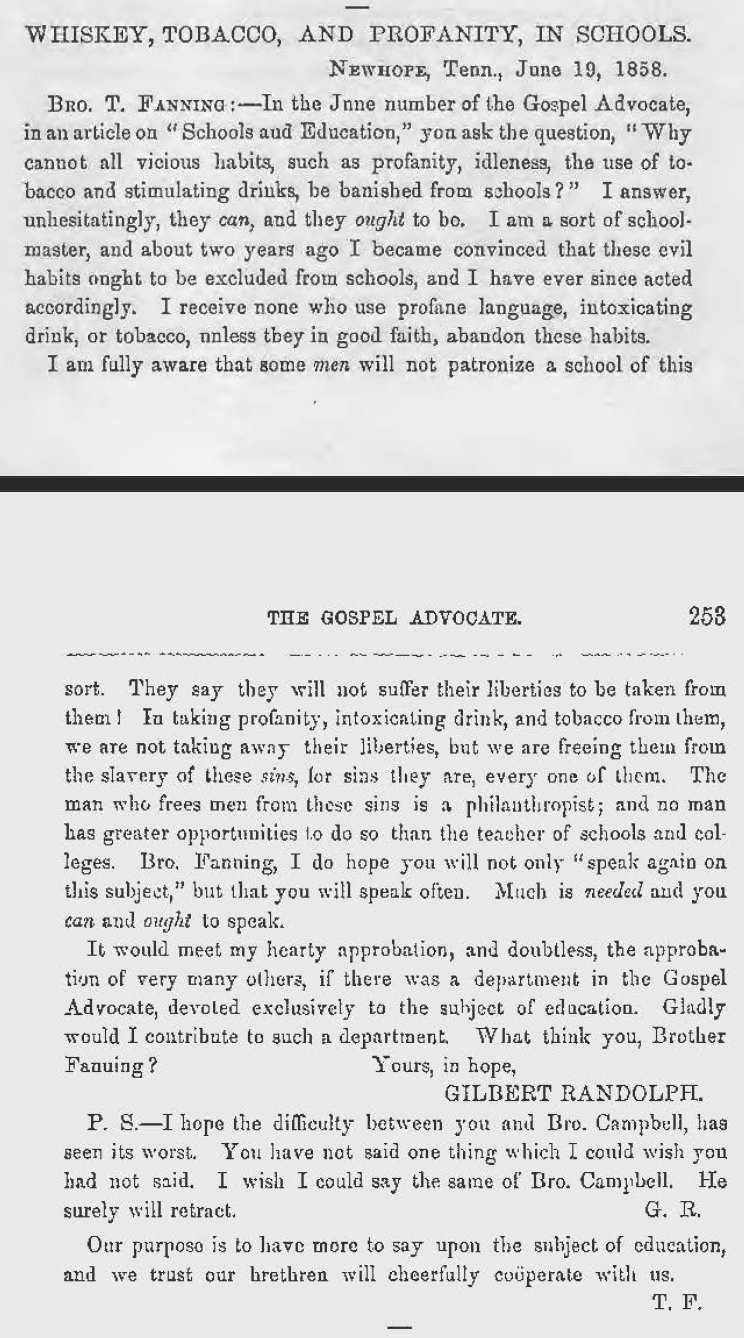
Gospel Advocate, 08.08.1858, pages 252, 253
![]()
Restoration Highlights
Spring Creek Church Early Example of Missionary Cooperation
The Spring Creek Church of Christ in McMinn County, Tenn., was involved in a grand effort of mission work from its beginning. In cooperation with other congregations in the lower East Tennessee counties and upper Georgia, this endeavor established congregations, exhorted the weak, and converted many to the cause of Christ.
In the first half of the 19th century, the intrinsic force of truth, proclaimed by self-sacrificing evangelists traveling on foot or horseback in cold and heat and preaching in rude shelters, in brush arbors, by home firesides and in schoolhouses, had an impact upon the religious thinking of America that was outstanding and unique. Wherever these pioneers found a listening ear, they preached because they loved the Word of God and were inspired with a missionary zeal. Such was the planting and watering in the rolling hills of McMinn County without societies, state boards or national organizations.
Beginnings. Just what date the first group gathered together is unknown, but it was probably in the early 1820s. The settlers were already religiously oriented, and by 1830 they were well-established with an adequate meetinghouse on land owned by John Roberts. On June 9, 1830, Roberts made a "deed of gift," donating the land on which the building stood to the church.
The trustees receiving the deed for the "Church or Congregation of Christ" were Westly (Wesley) Spearman and Robert Mancil (Mansell). It was witnessed by Robert Randolph and Willis Burke. John, Edmond and Thomas M. Roberts from South Carolina were active participants from the first. William McNabb, Robert Mansell and James Billingsley were elders and preachers. Robert Randolph, a convert of the Rockwood (Post Oak Springs) church, the Mees, and Thomas, John and Wesley Spearman also from South Carolina were early settlers at Spring Creek. Isaac Rice moved his family to McMinn to his Mantua (Rest); this became Riceville.
Thomas Miller arrived around 1825 from Monroe County, Ky., where he served as a deacon in John Mulkey's Mill Creek Christian Church (Old Mulkey). The Erecksons, Whites, Stones and others were among the group.
Preachers. Robert Randolph was ordained to preach in 1822 in Virginia. He and kinsmen, *Elisha and Elihu, soon became known as sound proclaimers of the Word. Robert Randolph became a leader of the Spring Creek church for the first 25 to 30 years. Rees and William Jones moved to the area about 1826. Soon converted to this "strange new doctrine," they both were "ordained to preach" Aug. 16, 1833, at the Meadowfork church on Eastanallee Creek by the imposition of hands by Robert Randolph and Isaac Mulkey, elders. John Mulkey moved from Kentucky to McMinn County, and he and his sons were active in evangelizing. John Spearman was active in the camp meetings. Ephraim A. Smith and John R. Frame of Ohio were paid evangelists. Green Berry Stone of Cleveland, Tenn., preached for many years. Williamson Ereckson was the resident preacher at Spring Creek after the Civil War. Many young preachers were tutored and encouraged by the early preachers of the cooperation. Among them were John Jack, Walter B. Mansell, James Billingsley, C. Jones, John Davis, John Spearmen, John Hutcheson, John H. Acuff, L.R. Lawson, William Smith, Gilmore and Gilbert Randolph, J. Madison Love, E.M. Berry and a host of others.
Evangelism. From the earliest days, Spring Creek was a missionary-minded church. Their "elders" or preachers went forth diligently preaching and establishing congregations.
Rees Jones and Robert Randolph held meetings, established churches and exhorted. In the summer of 1834, Robert Randolph, John Mulkey and William D. Carnes were riding circuit and holding meetings from Roane to Bledsoe County. They traveled long distances preaching and passing out Bibles and tracts. Soliciting subscriptions to early periodicals put teaching in the homes. J.J. Trott and John Eichbaum were sent out by Franklin College to preach in destitute places, and they shared in cooperative efforts with Robert Randolph and Rees jones.
In 1833 Spring Creek and Liberty Hill congregations were meeting regularly to "break bread each first day." Each had about 60 members. Many smaller congregations were established by these old "saddlebag" preachers, but it took constant attention to keep them alive and thriving. Cooperation. The cooperation was developed out of a need to have men capable of proclaiming the truth, being totally dedicated to the "back to the Bible alone" concept. Members were mostly poor farmers, some merchants and teachers who could not easily support a full-time minister. They realized they must band together, pool their efforts, and work with one another. The men who were well-versed in Scripture were few, and they were needed in so many places. But often they were in dire need from lack of support, and they had to take time to labor for bread.
In the fall of 1849, Robert Randolph sent a report of a meeting at Smyrna Meeting House, Bledsoe County, at which seven congregations met to unite in a "permanent cooperation for the promotion of 'Primitive Christianity.'" Evangelists would be selected to visit the churches within the bounds of the cooperation, help build up and increase, preach, and plant new churches.
The first cooperation meeting was held Nov. 29, 1849, at Spring Creek with other congregations joining the endeavor. The circuit to be covered was 150 by 65 miles and was cut from a wide berth of upper Georgia up through Tennessee. There were 12 churches in seven counties in 1849-50 that sent representatives and support. Robert Randolph, Gilmore Randolph, and Ephraim A. Smith were selected as evangelists.
The second meeting was held in October 1850 at Spring Creek with Robert Randolph, James D. Billingsley and John R. Frame selected. It took three months to make the "grand rounds."
When the cooperation began in 1849, a total of 357 members were accounted for in the 12 churches with $390.20 pledged for evangelizing. By 1859, 20 churches were participating, embracing 12 counties in Tennessee and several in Georgia with an aggregate membership of 1,200. Spring Creek continued to host the meetings. They had a campground, and entire families came in wagons to camp and have fellowship. Usually beginning on Thursday or Friday night and continuing through Sunday, these were a highlight for the brethren.
During the 1850s many members were lost to the severe drought and to the appeal of open farm lands in Texas. The strife leading up to the Civil War and the internal problems that followed wrecked havoc for some time. Open rebellion, resentment and even open warfare among advocates of the North and South pitted neighbor against neighbor, and the churches often fell by the wayside.
By 1871 efforts were underway to re-establish the evangelism of prewar days. In May 1872 delegates of several of the stronger churches met at Blue Springs Church in McMinn County in consultation with reference to the welfare of the churches and to secure more evangelism. They extended an invitation to all preachers, elders, brethren and sisters of adjoining counties to meet in October at Blue Ridge.
Provisions were made for those who came from a distance. It was a harmonious meeting; the preachers gained fresh courage and went home resolved to be more faithful and energetic in the cause of Christ. It was agreed that "There must be a unanimity of action, of purpose and of determination." They believed that a golden opportunity had come for them to help themselves and set the cause of Christ on a proper footing in East Tennessee. They called on all who were willing to make sacrifice to do so.
G. A. Randolph, G. B. Stone, E. M. Berry and "Father" Acuff were speakers for the two-day meeting. The topics and speakers chosen for the next meeting were: antichrist, love, spiritual influence, purity of the church, utility of the Lord's Day school, and prayer. Now, 100 years away, this would fit comfortably in one of our own modern lectureships.
District cooperations had begun as early as 1831 in Virginia and spread to other states. There was some opposition to them. However, most brethren acknowledged there must be some way to cooperate in order to evangelize.
In the same month that the Spring Creek cooperation was determined to be set in motion, October 1849, a large group of brethren met at Christian Chapel in Cincinnati to discuss church organization; the end result was the American Christian Missionary Society. It was organized with its own executive board and managers and with authority to enact bylaws, establish agencies, hire, pay and instruct those employed. Anyone who paid $10 a year could be a delegate.
This organization was a superstructure to usurp the church's function of evangelizing and through it control that which could be done and taught. To compare the society with the simplicity of the cooperative endeavors of the lower East Tennessee and upper Georgia churches leaves us with no doubt that they were not of the same class.
The differences between them was set forth ably by John Eichbaum in the Christian Magazine in 1850. He pointed out that the cooperations were merely gatherings of brethren to discuss and provide ways to evangelize their surrounding areas with each congregation involved contributing toward the support of evangelists. They were extremely successful in the early days of the restoration.
Yet with time and progress, these expanded to the state level, and efforts to organize them into state boards and state missionary societies brought about many pitfalls that spelled doom for the unity of the brotherhood, eventually spawning many divisions. The error lay not with the cooperation of churches to evangelize and accomplish the missionary aims of the Bible but in the determination to organize and establish ruling boards outside of and beyond the apostolic examples.- 1508 E. Magnolia, Sherman, TX 75090
-Ethelyn Barnes Mitchell, Gospel Advocate, May 7, 1987, pages 268, 269.
*Note: Some historians conclude that Elisha Randolph (1785-1856) and Elihu Randolph (1803-1850) were related. Elihu was Robert Randolph's brother, as noted above. Their father was William Byrd Randolph, Sr. (1854-1858), a Virginian, and Revolutionary War soldier, who around 1810 left Baptist creeds to take the Bible alone as his authority in religion. His sons, Robert and Elihu preached, and possibly another son, William Byrd Randolph, Jr. (1796-1881). William Byrd, Jr. had two sons who also preached, Gilbert A. Randolph (1820-1885), the subject of this page, and his brother Gilmore Randolph (182-1904). The Elisha Randolphs were from North Carolina. His father was John R. Randoph (1759-1815), and died on Randolph Mountain, north of Berry, in Fayette County, Alabama.
![]()
Directions To Grave
Take I-75 north from Chattanooga, Tennessee and south from Knoxville, Tennessee. Go to Cleveland, and take the Georgetown Rd. Exit. Hwy. 60. From there you are about 15 miles from Mount Bethel Cemetery. This is the bypass, so head east about half way around the city and take a left on Spring Place Rd. SE (Hwy 74). Go about 5.4 miles and turn right on Keith Valley Rd. In another 4.2 miles turn right on Mt. Bethel Road. The cemetery is on the right. Enter the cemetery, and around the middle is the Randolph Family Plot.
GPS Location
35°01'06.3"N 84°50'42.1"W
or D.d. 35.018422, -84.845038
![]()

S. D. Wife Of
G.A. Randolph
Born
October 21, 1820
Died
June 28, 1894
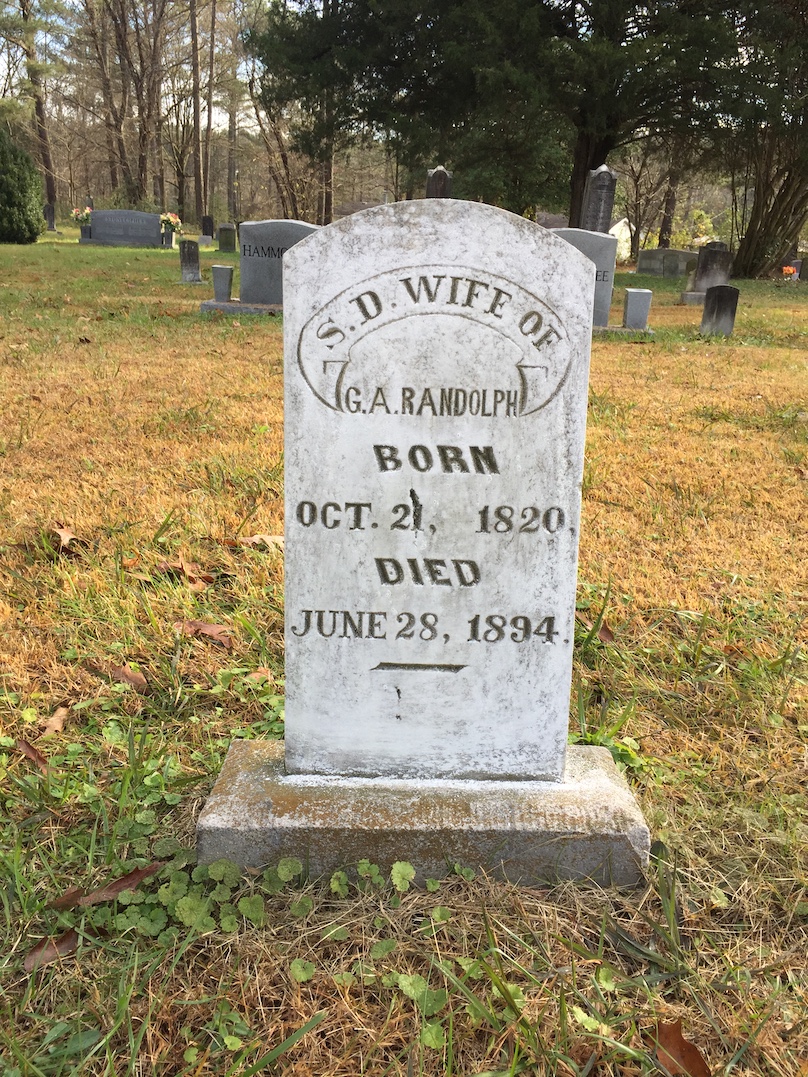
Sarah Doranda Myers Randolph
S.D. Wife of
G.A. Randolph
Born
October 21, 1820
Died
June 28, 1894
G.A. Randolph
Born
April 20, 1820
Died
![]()
Photos Taken 11.25.2015
Webpage Produced
07.31.2021
Courtesy Of Scott Harp
www.TheRestorationMovement.com
![]()
